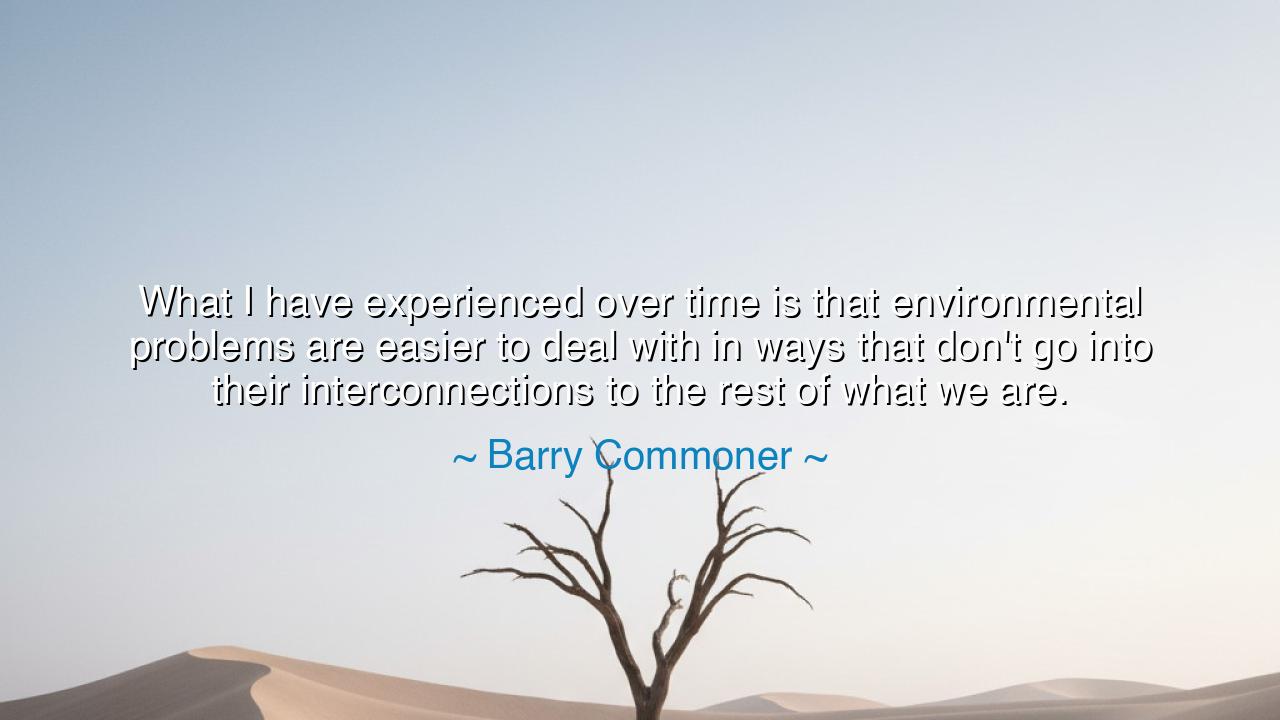
What I have experienced over time is that environmental problems
What I have experienced over time is that environmental problems are easier to deal with in ways that don't go into their interconnections to the rest of what we are.






The words of Barry Commoner, “What I have experienced over time is that environmental problems are easier to deal with in ways that don't go into their interconnections to the rest of what we are,” shine with the paradox of human understanding. They reveal how tempting it is to treat each wound of the earth in isolation—polluted rivers as one issue, smog as another, poisoned soil as yet another—while ignoring the deeper truth: all these problems are not separate, but threads woven into the same great tapestry of life. Commoner, one of the great voices of environmental science, understood that to face the full interconnection of these crises is overwhelming, but to deny their unity is dangerous.
The origin of this saying lies in Commoner’s lifelong struggle to awaken humanity to the truth of ecology. As a biologist and activist, he taught that the earth is not a collection of parts but a living whole, where every act reverberates through countless unseen chains. Yet he also knew that in public life and politics, people preferred simpler answers: a new filter here, a new rule there, a patch on one problem without facing the root cause. It was always easier to mend the branch than to confront the sickness in the roots. Thus he spoke this truth, half as lament, half as warning—that the easier path is to treat symptoms, while the harder but necessary path is to see the interconnections of what we are.
History offers us a vivid story in the tragedy of DDT, the pesticide once hailed as a miracle. When first used, it was seen only as a solution to pests and disease. The problem seemed contained and easily solved: kill the insects, save the crops, protect human health. But Rachel Carson’s Silent Spring revealed the deeper interconnections: the poison did not remain on the insects, but spread through birds, rivers, fish, and eventually into human bodies. What had seemed an isolated problem was in truth a chain reaction touching every corner of life. The refusal to see interconnections nearly silenced entire species, including the bald eagle.
This is the essence of Commoner’s wisdom. Environmental problems are not solitary puzzles; they are reflections of humanity’s deeper relationship with the earth. Air pollution is tied to energy consumption, which is tied to economic systems, which are tied to politics, which are tied to values of consumption and greed. To address one without seeing the others is easier, yes, but it is like cutting weeds without pulling the roots—they return, and stronger than before. Commoner’s insight was that every problem points beyond itself, to the totality of “what we are.”
His words also remind us of the courage required to face these truths. To acknowledge interconnection is to admit responsibility. It is easier to blame a single factory for a polluted river than to confront the reality that our demand for cheap goods fuels those factories. It is easier to curse the smoke above the city than to ask how our own cars, lights, and devices contribute to it. By refusing interconnection, we protect our comfort. By embracing it, we awaken to the depth of our duty.
The lesson for us is both humbling and empowering. If we desire real change, we must look beyond the surface of problems and see the whole. When we recycle, let us also question why so much plastic is made in the first place. When we conserve water, let us also consider how agriculture, energy, and industry consume rivers and aquifers. When we plant a tree, let us remember the forest that was lost and work to restore it. Interconnection means that no action is too small, but also that no solution can stand alone.
Therefore, let each of us act with wisdom. Do not turn away from complexity; embrace it. Let your mind stretch to see the hidden bonds between food, energy, soil, and spirit. Teach your children not only to clean a riverbank, but to understand why the river was polluted. Support leaders who see beyond patches and propose transformations. And in your daily life, remember that every choice touches countless lives, human and nonhuman alike.
So let Commoner’s words echo as a guiding truth: “Environmental problems are easier to deal with… when we ignore their interconnections.” But ease is not salvation. True healing comes only when we face the whole, when we accept that humanity and nature are one fabric, and that every thread pulled disturbs the entire weave. Let us be the generation that dares to see fully, that labors not only for quick fixes but for lasting harmony, so that the tapestry of life may endure in strength and beauty for ages to come.






AAdministratorAdministrator
Welcome, honored guests. Please leave a comment, we will respond soon